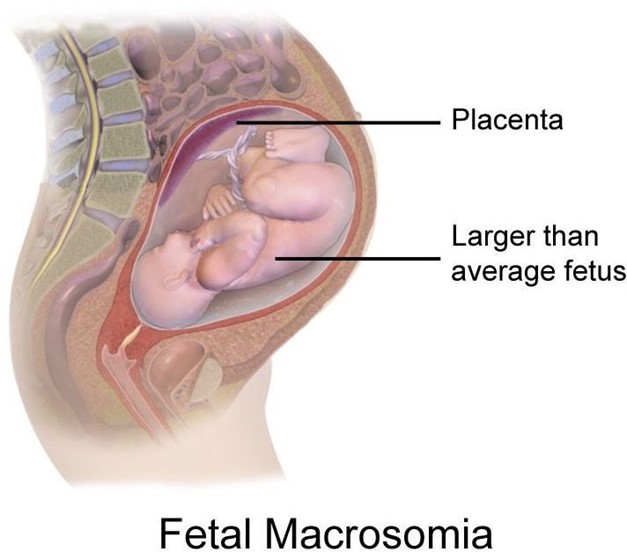Obstetrical risks to consider for a pregnant teenager would be all of the following, EXCEPT: Select one:
Macrosomic fetus.
Preeclampsia.
Inadequate nutritional status of mother.
Cephalopelvic disproportion.
The Correct Answer is A
Choice A Reason: Macrosomic fetus is a fetus that weighs more than 4000 grams or 8 pounds 13 ounces at birth. It is not a common complication of teenage pregnancy, but rather of maternal diabetes, obesity, or a history of large babies.
Choice B Reason: Preeclampsia is a condition characterized by high blood pressure and proteinuria in pregnancy. It can cause serious complications for both the mother and the baby, such as seizures, organ damage, growth restriction, and placental abruption. Teenage pregnancy is a risk factor for preeclampsia, especially if the mother is younger than 15 years old.
Choice C Reason: Inadequate nutritional status of mother is a condition where the mother does not consume enough calories, protein, vitamins, minerals, or fluids during pregnancy. It can affect the growth and development of the baby and increase the risk of low birth weight, preterm birth, and birth defects. Teenage pregnancy is a risk factor for inadequate nutritional status of mother, as teenagers may have poor dietary habits, eating disorders, or limited access to food.
Choice D Reason: Cephalopelvic disproportion is a condition where the size or shape of the baby's head or body is too large to fit through the mother's pelvis. It can prevent normal vaginal delivery and require cesarean section. Teenage pregnancy is a risk factor for cephalopelvic disproportion, as teenagers may have smaller or immature pelvises that are not fully developed.

Nursing Test Bank
Naxlex Comprehensive Predictor Exams
Related Questions
Correct Answer is D
Explanation
Choice A Reason: About 1 of every 5 women will experience abuse in her lifetime is a statistic that shows the prevalence of domestic violence, but it does not address the question of what the nurse should emphasize to the group of women.
Choice B Reason: When women go back to the situation after the abuser has calmed down, things will be beter is a false statement that reflects the cycle of abuse, where the abuser may apologize and promise to change after a violent episode, but then repeat the same behavior later. This does not help the women understand their situation or seek help.
Choice C Reason: The victimized woman can easily leave the situation is a false statement that ignores the many barriers and challenges that women face when trying to escape from domestic violence, such as fear, isolation, financial dependence, lack of support, legal issues, and threats from the abuser. This does not empower the women or provide them with realistic options.
Choice D Reason: The violence will not stop or decrease if the woman becomes pregnant is a true statement that highlights the danger of staying in an abusive relationship during pregnancy. Domestic violence can increase the risk of miscarriage, preterm birth, low birth weight, placental abruption, fetal injury, and maternal death. This may motivate the women to seek safety and protection for themselves and their unborn children.
Correct Answer is A
Explanation
Choice A Reason: Episodes of hypoglycemia and hyperglycemia. This is because episodes of hypoglycemia and hyperglycemia are common complications of diabetes during pregnancy, which can affect both the mother and the fetus. Hypoglycemia is a condition where the blood glucose level drops below the normal range, which can cause symptoms such as sweating, trembling, hunger, confusion, or loss of consciousness. Hyperglycemia is a condition where the blood glucose level rises above the normal range, which can cause symptoms such as thirst, polyuria, fatigue, blurred vision, or ketoacidosis. Diabetes during pregnancy requires careful monitoring and management of blood glucose levels to prevent adverse outcomes such as fetal macrosomia, congenital anomalies, stillbirth, or neonatal hypoglycemia.
Choice B Reason: Postpartum hemorrhage. This is an incorrect answer that refers to a different complication that may occur after delivery, not during pregnancy. Postpartum hemorrhage is excessive bleeding from the uterus or genital tract after delivery, which can cause hypovolemic shock, anemia, or death. Postpartum hemorrhage can be caused by uterine atony, retained placenta, lacerations, or coagulation disorders.
Choice C Reason: Cerebrovascular accident (CVA). This is an incorrect answer that indicates a rare and severe complication that may occur during or after pregnancy, not specifically related to diabetes. CVA is also known as stroke, which is an interruption of blood flow to the brain due to ischemia or hemorrhage, which can cause neurological deficits or death. CVA can be caused by hypertension, preeclampsia-eclampsia, thrombophilia, or vascular malformations.
Choice D Reason: Acute vasospasm. This is an incorrect answer that suggests a different condition that may occur during pregnancy, not associated with diabetes. Acute vasospasm is also known as Raynaud's phenomenon, which is a disorder of blood vessels that causes them to narrow and reduce blood flow to the extremities in response to cold or stress, which can cause pain, numbness, or color changes. Acute vasospasm can be triggered by smoking, medications, or autoimmune diseases.

Whether you are a student looking to ace your exams or a practicing nurse seeking to enhance your expertise , our nursing education contents will empower you with the confidence and competence to make a difference in the lives of patients and become a respected leader in the healthcare field.
Visit Naxlex, invest in your future and unlock endless possibilities with our unparalleled nursing education contents today
Report Wrong Answer on the Current Question
Do you disagree with the answer? If yes, what is your expected answer? Explain.
Kindly be descriptive with the issue you are facing.
